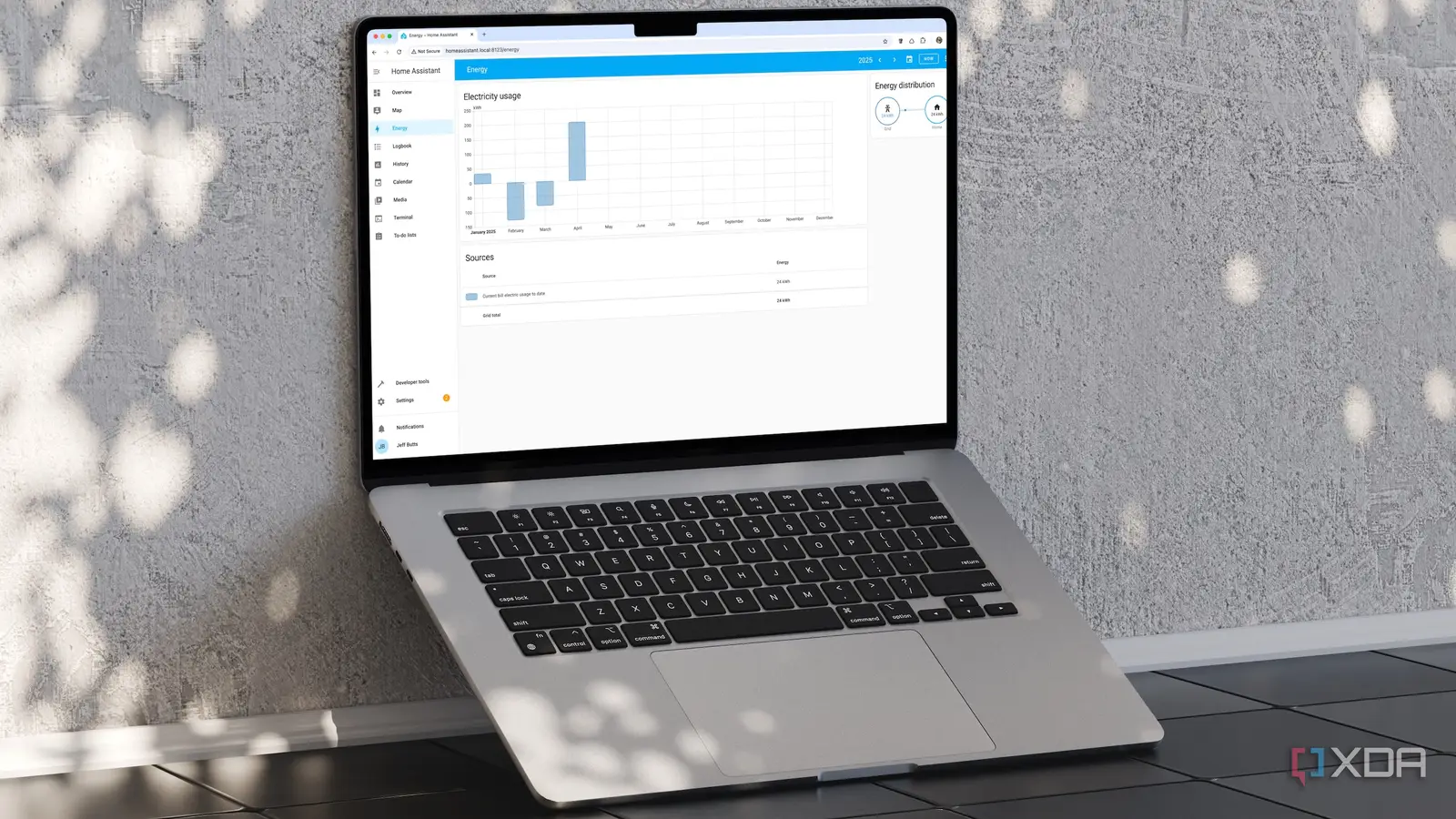
Home Assistant is flexible enough to run on a wide range of hardware, but in my experience, nothing matches the Raspberry Pi 4B or 5. It isn’t just about convenience or power efficiency, though those matter too. The Pi unlocks certain features, integrations, and community support that you’ll struggle to find anywhere else. For anyone serious about automating their home, a dedicated Raspberry Pi is the best foundation you can give your setup.
GPIO-based automations and sensors
Hardware-level integrations need Raspberry Pi GPIO pins
One of the most significant advantages of running Home Assistant on a Pi is access to its GPIO pins. These pins open the door to hardware-based automations you simply can’t replicate on most other systems. You can wire in PIR motion sensors, magnetic reed switches, relays, and even simple LEDs to create direct triggers and outputs. Without GPIO, entire categories of DIY automations disappear from your toolkit, leaving you stuck with only wireless solutions.
This matters most for tinkerers who want to push beyond plug-and-play smart devices. A GPIO-controlled relay, for instance, allows you to switch low-voltage circuits without needing a smart plug or an expensive hub. Likewise, simple contact sensors can be wired directly into the Pi instead of relying on wireless alternatives that may be less reliable or more expensive. GPIO support also makes it possible to experiment with one-off ideas that may never hit the mainstream but are fun to try out. The more hands-on you are with Home Assistant, the more valuable these pins become in day-to-day projects.
Running Home Assistant in a VM or on a NAS eliminates this option. You can sometimes approximate it with USB boards or network-connected microcontrollers, but it’s never as straightforward or well-documented as using the Pi’s native GPIO. Even when it works, the added complexity means more things can break at any given moment. For me, this makes the Pi the obvious choice, because I want my automations to be both powerful and reliable without endless tinkering.
Official Home Assistant OS support
Raspberry Pi gets the most reliable and complete builds
The Home Assistant Operating System is designed and tested with the Raspberry Pi in mind. That means you get the most reliable updates, the least hassle with compatibility, and the smoothest setup experience. Other platforms often require a supervised installation that lacks some of the polish and stability that HAOS on a Pi guarantees. The result is a system that feels seamless and predictable from the very beginning.
Supervisor itself is critical because it provides a managed way to handle updates, add-ons, and system monitoring. Without it, some integrations and add-ons won’t even be available, and troubleshooting becomes significantly more complicated. On a Pi, everything is baked in and ready to go, so you spend more time automating and less time fixing issues. That alone is a major reason why the Pi remains the recommended platform, as endorsed by the developers themselves.
There are also countless add-ons and integrations written with the assumption that you’re running HAOS. If you’re in an unsupported environment, you may encounter installation errors or unexpected behavior that no one else in the community has documented. Over time, that gap grows because Pi-based installs get the first round of fixes and improvements. The Pi keeps things simple and ensures you’re always running the version of Home Assistant that’s best supported.
Expansion with HATs and daughterboards
Zigbee, Z-Wave, and PoE HATs only work on Pis
The Raspberry Pi’s ecosystem of HATs is unmatched when it comes to expanding Home Assistant. Zigbee and Z-Wave HATs, for example, slot right onto the Pi’s header, giving you a rock-solid radio without the need for external dongles. Power-over-Ethernet HATs make it easy to mount your Pi in a central location and power it through your network cable, keeping wiring neat and reliable. These HATs are designed explicitly for Pi users who prefer compact and stable setups.
These HATs don’t just simplify things — they reduce the number of potential points of failure. A HAT is always there when the Pi boots, whereas a USB dongle might disconnect, fail to initialize, or be mismanaged by a hypervisor if you’re running in a VM. Fewer moving parts means fewer headaches, and in a system designed to stay on all the time, that’s a serious advantage. Over the long term, that stability pays off when you don’t need to re-pair or rebuild your mesh network.
If you choose to run Home Assistant on a NAS or mini PC, you lose access to this ecosystem. You’re forced to rely on USB dongles or network bridges, which can work but rarely offer the same stability. You also miss out on the creativity of the HAT community, where new boards often appear before equivalent USB devices do. This is one of the clearest reasons why the Pi stands apart as the platform Home Assistant was built for.
Reliable USB device passthrough
Radios and dongles work better on native hardware
Even if you decide not to use a HAT, you’ll still want to connect radios and dongles for Zigbee, Z-Wave, Bluetooth, or Matter. On a Raspberry Pi, you just plug them in and get to work. The drivers are stable, the connection is direct, and you don’t have to fight with virtualization layers. This keeps latency low and ensures your smart home mesh remains reliable no matter how large it grows.
VMs and Docker setups, on the other hand, can make USB passthrough a nightmare. Sometimes the dongle won’t reconnect after a reboot, or latency issues will cause your Zigbee mesh to behave inconsistently. In other cases, the hypervisor may drop the device altogether, forcing you to re-pair everything. For a system as critical as Home Assistant, these minor issues quickly snowball into major headaches when devices stop responding.
Keeping Home Assistant close to its hardware is the best way to ensure reliability. A Pi provides that direct connection without compromise, while also offering the flexibility to expand with multiple dongles if needed. You also avoid wasting time on workarounds and troubleshooting USB passthrough settings. It’s the kind of reliability you’ll appreciate most when you’re away from home and everything still works flawlessly.
Home Assistant Community Store support
HACS works best on supervised Raspberry Pi setups
The Home Assistant Community Store, or HACS, is where you’ll find custom integrations, themes, and automations that are not covered in the official repositories. It’s one of the most powerful ways to extend Home Assistant, and for many users it feels just as essential as the core integrations. The catch is that HACS depends on Supervisor, which isn’t available on every installation method. Without Supervisor, you’re shut out from thousands of community-built extras.
When you’re running HAOS on a Raspberry Pi, HACS is simple to install and just works. That means you can tap into everything from advanced device integrations to clever dashboard cards, all designed and tested by the community. Many of the most popular blueprints and dashboards currently available depend on HACS, making it even more crucial to have it functioning correctly. Being cut off from HACS feels like losing half of what makes Home Assistant so versatile.
If you run Home Assistant on unsupported hardware, HACS can become a chore or fail entirely. The installation process is more fragile, updates may not work as expected, and support is harder to find because fewer people use it in this way. On a Pi, you sidestep all those problems and keep the door open to everything the community has to offer. The Pi guarantees that you’ll always be able to take advantage of the latest community contributions without frustration.
Community guides and compatibility
Most documentation assumes Raspberry Pi hardware
Home Assistant has a thriving community, but nearly all of its tutorials and guides assume you’re running on a Raspberry Pi. That’s because the Pi is the most common starting point, and developers naturally test their work there first. If you want a smooth experience following a YouTube tutorial or a written guide, being on a Pi keeps you in lockstep with the instructions. It saves time and avoids confusion when the guide references hardware-specific steps.
This consistency is invaluable when you’re troubleshooting. Instead of translating commands for a different OS or trying to guess how your hypervisor handles something, you can follow the steps exactly as written. Most of the time, community fixes and blueprints just work when you’re on the same hardware as everyone else. Even if you encounter problems, people in forums and chats are more likely to help if your setup matches theirs.
Choosing the Pi means you’re never fighting against the grain. You’re part of the majority setup, which provides you with better support, documentation, and a much easier path when you’re stuck. That’s not something you want to give up when your entire smart home depends on it. Over time, it also means your system evolves smoothly alongside the wider Home Assistant community, instead of drifting into an unsupported corner.
Why a Raspberry Pi is still the best choice
Other platforms might promise more power or let you consolidate services, but none of them deliver the full Home Assistant experience the way a Raspberry Pi does. From hardware-level integrations with GPIO and HATs to software advantages like Supervisor and HACS, the Pi keeps everything working together seamlessly. Add in the unmatched community support, and it’s clear why I’ll never run Home Assistant anywhere else. When reliability, compatibility, and feature access all come together, the Raspberry Pi is the only sensible option.



